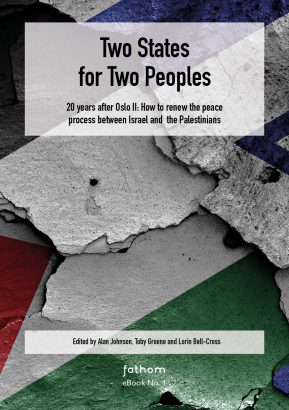To mark the 20th anniversary of the Oslo II agreement, Fathom has published an eBook – Two States for Two Peoples – a collection of essays and interviews drawn from the pages of Fathom focused on the two-state solution and how to reinvigorate it.
To download the eBook, click here.
Featuring: Hussein Ibish , Joshua Muravchik, Moshe Arens and Ami Ayalon, Cary Nelson, David Pollock, Einat Wilf, Shlomo Avineri, Ofer Zalzberg, Joel Braunold, Hitham Kayali, Isaac Herzog, Omer Bar-Lev, Ari Shavit, Benny Begin, Meir Kraus, Danny Seidemann, Lior Amihai, Dani Dayan, David Newman, Sapan Maini-Thompson, Michael Herzog, Gershon Baskin, Shlomo Brom , Efraim Halevy and Dore Gold.
***
When Israeli Prime Minister Yitzhak Rabin and PLO Chairman Yasser Arafat signed the ‘Interim Agreement’ at the White House on 28 September 1995, it was the high point of the Oslo Process. Two years after the initial Oslo Agreement, Oslo II was a key milestone, empowering the Palestinian Authority to govern all the large Palestinian population centres in the West Bank, and creating the division of powers according to Areas A, B and C that exists to this day.
The Interim Agreement was meant to last until 1999, by which time a permanent status agreement was meant to be negotiated. 20 years later, after several major attempts and much violence, hope for such an agreement seems faint.
The basic ingredients of the conflict remain the same now as they were 20 years ago: two entirely distinct national groups, both with legitimate claims to national self-determination in the same piece of land. The question we must ask ourselves now is, “Where does the peace process stand 20 years after Oslo II, and what must be done to keep it alive?”
The essays in this eBook offer thinking about the conflict orientated to understanding its complexity and how it can be resolved within a framework of recognition of rights on both sides. They reflect the following principles.
- Fair thinking: how can we target the drivers of conflict and encourage forces for peace and coexistence on both sides? On the Israeli side that may mean targeting settlement construction. On the Palestinian side it may mean targeting extremism, incitement, and antisemitism. On both sides it should be mean embracing and supporting those groups working within their own societies to promote peace as being in their nation’s own interests.
- Practical thinking: How can we improve the present reality, and ensure things don’t get worse? If a bilateral political agreement is currently beyond reach, are their unilateral or incremental steps that would improve the situation and the chances for a future agreement, reversing the current negative cycle?
- Creative thinking: If the conventional two state model envisioned by the Clinton Parameters has proven inadequate, are there new creative ideas that can solve old problems? There is no one-state alternative, but might there be unconventional ways in which the core demand of both sides – for distinct national sovereignty – be realised in overlapping spaces?
To download the eBook, click here.


































Comments are closed.